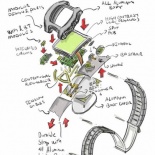3D printing allows early verification of prototype designs. While computer aided design (CAD) simulations allows designs to be evaluated and tested within a virtual environment before manufacture, a 3D printed prototype allows for in-situ field-testing and rapid physical visualisation of 3D models (e.g. verifying the position of mobile phone buttons to 90% percentile of population hand sizes), identifying and addressing design issues (such as ergonomics) beyond CAD simulations early before production, where subsequent design changes will be difficult and expensive to rectify.
It can make the global supply chain truly global
Moreover, design offices and clients these days may often reside in different countries or even continents. My time previously as an industrial freelance designer allowed me to work with many bright individuals, engineers and experts from all over the world leveraging on the each other’s expertise. At the heart of it is the ability to rapidly communicate design revisions, feedback and conceptualisation by simply printing an emailed part file on the spot or even to the customer. These physically printed prototypes also aid the communication of design intent between designers and clients, particularly for collaborations across multiple languages. The robo-hand project for instance is a classic example allowing a design office based in Washington State to rapidly push prosthetic hand designs to South African children with Amniotic Band Syndrome. The prosthetics are printed right in South Africa itself, allowing prosthetics sized to the growing children to be rapidly deployed from traditionally weeks to a few days at ten times the cost savings.
It has the potential to revolutionise the logistics industry
Besides allowing easy global cross-collaboration, 3D printing also has the ability to change the global logistics industry by shrinking and streamlining global supply chain through self-sufficiency. Here, parts can be printed where they are needed, when they are needed just-in-time, making the supply chain more robust against uncertainty. This destructive innovation allows for a completely radical way of seeing global logistics, potentially destruction of delivery services, yet creating nearly countless supply possibilities for management of frontline remote logistics train. Stores and factories can simply print parts to provide buffers for global shortages. Warehouses can store fewer inventory and reduce overstocking. Chemical molecular printers can rapidly deploy medicine or disaster supplies where needed in isolated regions. This “print anywhere” ideology will also allow militaries to increase combat endurance with lowered supply network reliance and print parts for replacement field repair parts or establish forward operating factories or on demand for changing mission needs (such as equipment or weapons behind enemy lines).
It allows high customisation of parts with significant cost savings and low wastage.
Putting together logistical and supply chain benefits has evident cost savings and uptime. The US Army has saved over $15M by using 3D printers to print instant replacement training UAV parts with 40% replacement lead time reduction with more equipment in the field. Furthermore, 3D printing allows new radical ways to print highly customised parts without the need for post-assembly, with desirable mechanical and corrosion properties. Unlike subtractive manufacturing, every kilogram of raw material for 3D printing translates directly to that same amount in parts, with minimal waste the printed part finished with minimal post printing processes. Functional parts (such as gearboxes) can be printed right in parts, eliminating the need for part post assembly. Medicine can be printed personalized to patient DNA sequence for increased effectiveness. The ability to print cells lays the foundation for full organs to be grown and cultivated for transplantation. Kidney cells laid by this technique has been successfully grown in the labs, creating the possibility of “organ on demand” overcoming global organ shortages. This streamlining of logistical and production processes with low waste ultimately result in lowered operating and manufacturing costs.
3D printed parts have better controllable mechanical and corrosion properties
3D printing allows for controllable part properties giving higher in-situ strength and corrosion resistance. This is achieved through the ability to plan isotropic or anisotropic printing orientations for the alignment of build materials (e.g. fibers) along desired loading paths giving better part performance and preventing part delamination. Moreover, as the printed part is often the finished product, this reduces the need of post-production welding, bending or forming. This provides greatly lowered probability of stress concentration, stress corrosion and formation of local brittle fracture points (especially in metals) with the elimination of failure modes induced from plastic deformation or microstructural incompatibility at interfaces, particularly evident in traditional manufacturing and assembly methods
With the good, comes the bad too.
» Next up, Disadvantages of 3D printing
(You are currently viewing page 2/3)
- Page 1/3 » Technology background and how it works
- Page 2/3 » Advantages, Benefits of additive 3D printing
- Page 3/3 » Disadvantages of 3D printing










I must say that overall I am really impressed with this blog.It is easy to see that you are impassioned about your writing.